Arts & Sciences Events
[PAST EVENT] Hao Xu: Physics Dissertation Defense
Location
Zoom
Hao Xu, Final Oral Examination for the Ph.D. Degree, Title: "Investigation of Stripes, Spin Density Waves and Superconductivity in the Ground State of the Two-Dimensional Hubbard Model"
Zoom info available upon request. Please email Ellie at evwilk@wm.edu.
Abstract: The Hubbard model is a "paradigmatic" model in the realm of condensed matter physics. In this study, we study the spin and charge orders, together with the superconducting pairing correlation in the ground state of the doped two-dimensional (2D) Hubbard model, with or without next nearest hopping.
A recent work employing a combination of several state-of-the-art numerical many-body methods established the stripe order as the ground state near 1/8 doping at strong interactions. In this work, we will employ one of these methods, the cutting-edge constrained-path auxiliary field quantum Monte Carlo (AFQMC) method with self-consistently optimized gauge constraints, to systematically study the model as a function of doping and interaction strength. With careful finite size scaling based on large-scale computations, we map out the ground state phase diagram of the pure Hubbard model (i.e., no hopping beyond nearest-neighbor) in terms of its spin and charge order.
The doped Hubbard model is widely believed to be relevant to high-Tc superconductivity in cuprates. We employ AFQMC together with the density matrix renormalization group (DMRG) method to study the superconducting order parameter in the ground state of the Hubbard model when a next-nearest-order hopping, t', is included. Our algorithmic advances include a more robust procedure for self-consistent constraint in AFQMC and twist average boundary conditions which can handle finite size effects more effectively. We compute the superconducting order parameter in the ground state for a number of parameter sets (t', doping) and discuss its interplay with magnetic and charge orders.
Bio: Hao Xu was born August 16th, 1995. He showed strong interest in math and science since he was in primary school. He entered the University of Science and Technology of China in 2011 and transformed into a physics major in his sophomore year. He received his bachelor’s degree in 2015 and chose William & Mary physics for his graduate study. Eventually, with his interest in both physics and coding, he joined prof. Shiwei Zhang's computational condensed matter group in 2017, focusing stripe and superconductivity study of Hubbard model. In his spare time, he ran several full marathons and ranked top 0.5% in Google Code Jam competition. After graduation, he hopes to use his math and coding skills to contribute in the field of finance or computer science.
